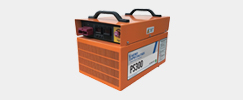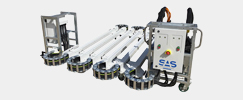
In the first of a new series that challenges the status quo, Ramp Equipment News (REN) put airport ground support equipment under the microscope, and turned to Powervamp to discuss the costs, environmental impact and the biggest question of all – how can it save you money!
Ground power is ground power…or is it?
For most aircraft operators, ground power is simply a necessary evil. It adds nothing to the status of aircraft in which billions of dollars are invested in order to reduce seat mile costs through fuel efficiency or increased capacity.
Yet, without reliable ground power, the impact on airlines can vary, from minor passenger inconvenience and flight deck issues to the catastrophic, such as the inability to start engines and subsequent flight cancellation. Add to this escalating inconvenience costs, all the way up to accommodation and associated expense.
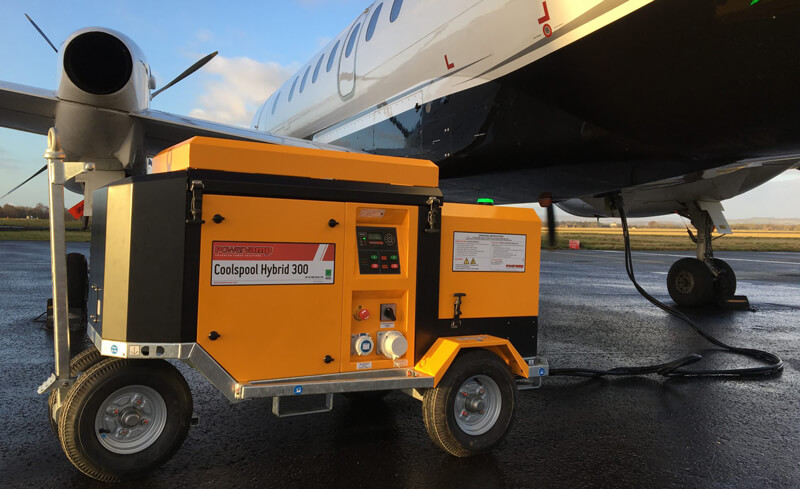
A Coolspool Hybrid 300 powering a Loganair Saab 340B out of Edinburgh Airport.
In between these extremes lie a variety of issues, the impact of which can affect despatch reliability or add to fuel burn costs through an APU’s continuous operation during turnarounds. As for the flight deck crew, the ground handlers, the airports and the airline management, as long as ground power works, that’s all that matters. But with margins under pressure as never before, operators are being forced to maximise efficiencies in every area.
This has never been truer than at this moment amongst the regional airlines. And this is precisely where Powervamp identified a need for a new approach to ground power for operators of DC commuter and regional aircraft to add to our aviation power solutions, including aircraft static inverters.
“..the Coolspool hybrid at full load consumes just 3.55 litres an hour…”
Let’s start with a rhetorical question: “Would you rent or buy a 10 tonne truck, just to collect the groceries from the supermarket?” Of course you wouldn’t, yet in GPU terms, that is precisely what many operators are doing.
Ground power has two functions: to power all the aircraft systems during turnarounds and maintenance and, briefly, to provide the power to spool up the turbines during the start cycle to a self- sustaining state. The difference between those two requirements, as measured in amps, can exceed 1,800 amps.
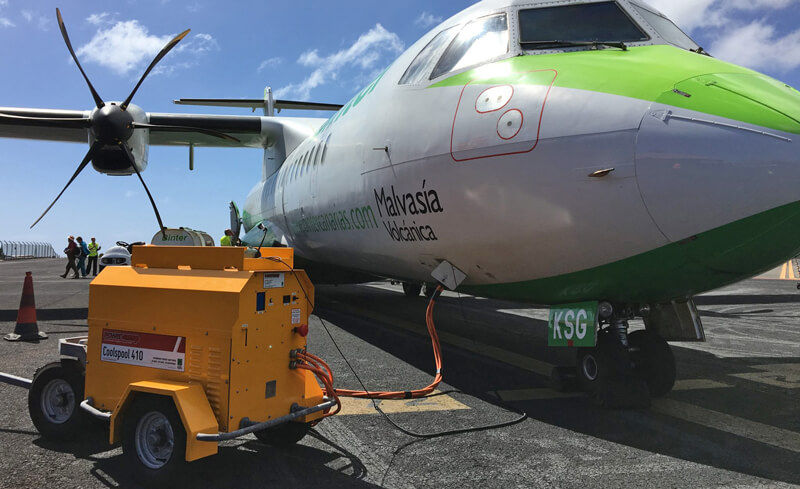
Powervamp Coolspool 410 in service with a Binter Canarias ATR 72-600, Spain.
For a typical regional aircraft such as the ATR, 160-190 amps are all that’s required during turnaround. Depending on the power plant and ambient temperature, up to 2,200 peak amps can be demanded at the point of starter/generator engagement for perhaps two seconds, reducing steadily to perhaps 600 amps over a 30 second period.
A GPU for a regional DC aircraft will therefore spend its life delivering typically 190 amps for 40-45 minutes during turnarounds, except for a brief two second period, during which time it has to provide 2,000 amps. This load will rapidly reduce to approximately 600 amps during a total start time of maybe half a minute.
“…pilots have expressed astonishment at the delivery achieved by such a small, compact and quiet GPU…”
In a unique reversal of accepted design philosophy Powervamp, with its latest Coolspool Hybrid 300 DC GPU, utilises a very small Tier IV compliant Kubota diesel engine of less than a litre instead of a diesel engine of more than four times the size and several times the cost.
In fuel burn the Coolspool hybrid at full load consumes just 3.55 litres an hour, (0.93 US gallons), and with the power consumption of most regional or commuter aircraft, will burn only 2.4 litres an hour (0.63 US gallons an hour). Contrast these fuel burn figures with a typical large diesel GPU, where fuel burn can be between 25-35 litres per hour, (6.6- 9.4 US gallons per hour), and the savings in fuel alone are significant.
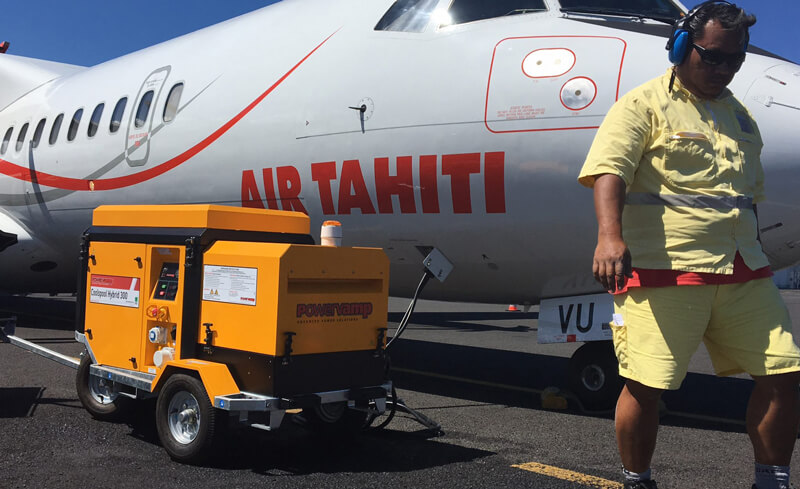
Air Tahiti rely on the Coolspool Hybrid 300 for daily engine starts of their ATR 72-600 aircraft.
The Kubota is perfectly matched to the integral power supplies, delivering up to 300 amps of continuous power. However, for the brief period of very high amps required during the 30-40 second start cycle, Powervamp’s Coolspool 300 Hybrid uses a combination of ultra high discharge batteries connected to its unique power boost system, a feature which delivers the amperage and voltage for a sustained time that exceeds all known start cycles on free and shaft turbine engines.
Indeed, so smooth and powerful is the pure DC power delivery that pilots have expressed astonishment at the delivery achieved by such a small, compact and quiet GPU, noting that the voltage drop at the moment of starter engagement is far less than from a GPU quadruple the size.
“…for Air Tahiti, Powervamp identified two distinct requirements and sent a Coolspool 410 followed by the Coolspool 300 Hybrid…”
Globally, there are hundreds of commuter and regional operators dependent on local FBOs, ground handling companies and the airline’s own support team or its sole dispatcher at a remote airport. All aircraft require power from some source and the cost of providing the power should be an important consideration.
Let us consider Azul Airways and Air Tahiti as examples: both of these carriers are high profile and service a very extensive network. They are also heavily dependent on their fleet of ATR 42 And ATR 600-72 aircraft. In the case of Air Tahiti, some flights are operated under ETOPS rules because of the remoteness of some of their destinations in the South Pacific. Both operators have major hubs and both fly to remote airports.
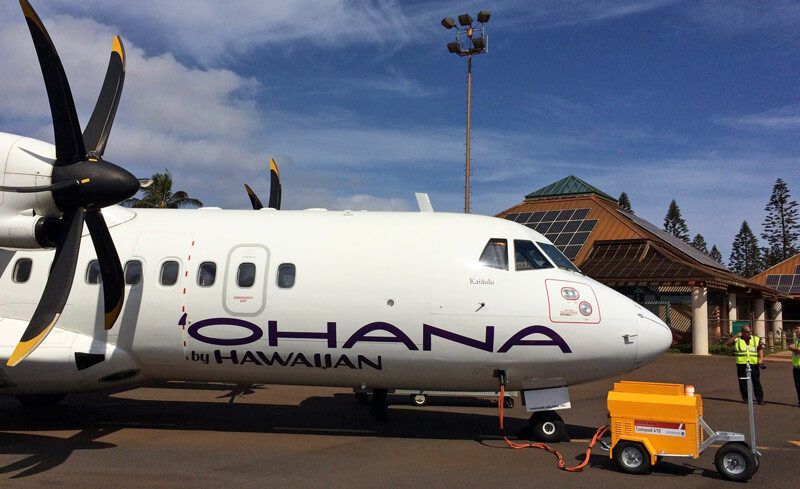
The Coolspool 410 provides clean DC power to the ‘Ohana by Hawaiian’ owned ATR 42-500 aircraft.
Tailoring an airline’s ground power to these varying airports used to be a crude, “one size fits all” type of approach. With the high cost of a conventional GPU, “one size” typically meant no ground power at remote airports and large inefficient diesel GPUs at busy airports or at the main hub.
Adding to the situation was the cost of bore glazing and consequent high fuel and oil consumption caused by running for long periods under a light load.
“..Powervamp offered to prove how it had the right product for each specific situation by providing a free trial unit…”
Solving these issues was a priority for management at both Azul and Air Tahiti. Powervamp offered to prove how it had the right product for each specific situation by providing a free trial unit.
In the case of Azul, Powervamp shipped one of its large DC Coolspool 410 28V DC battery carts to its ATR base in Belo Horizonte for extensive trials. For Air Tahiti, Powervamp identified two distinct requirements and sent a Coolspool 410 followed by the Coolspool 300 Hybrid.
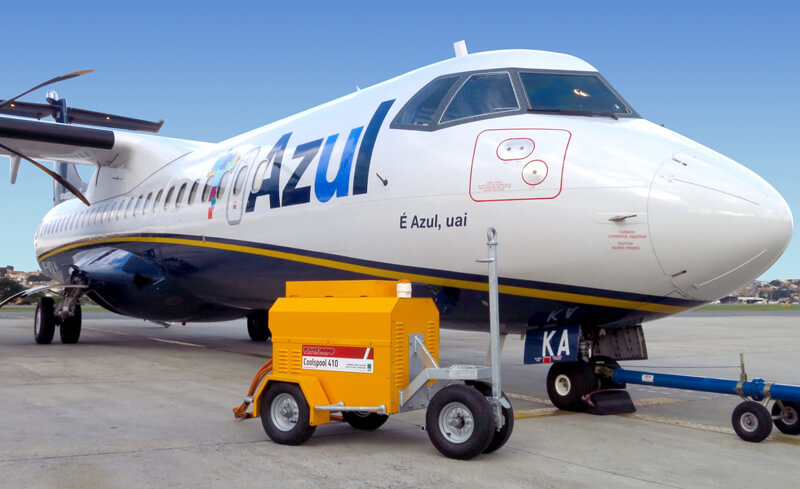
Brazilian Airline, Azul, is a long time user of the Coolspool 410 ramp cart on its fleet of ATR 72-600 aircraft.
The trials duly terminated and for both airlines, the benefits have been tangible: each has placed multiple orders for the product, a testimony to the savings and performance of both types of GPU.
In capex justifications subsequently shared with Powervamp’s management, both airlines enumerated some key benefits. With the 410 cart, no maintenance was required and a ten minute introduction fulfilled any training requirement. Investment was low and the unit suited to remote and infrequent operation. Pollution was absent and noise levels lower, resulting in less fatigue for the handlers involved. Easily moved by hand, the unit was quickly adopted by handling teams. The Hybrid scored equally well, with praise for its battery function.
So… are you still in love with the idea of taking a truck for food shopping?
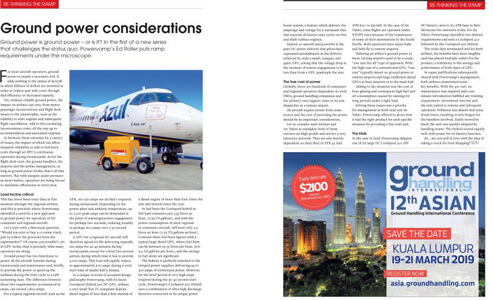
Our thanks to Alwyn Brice and Ramp Equipment News for permission to reproduce this article.





